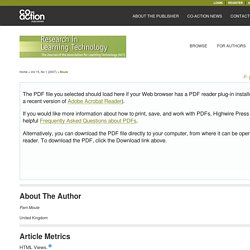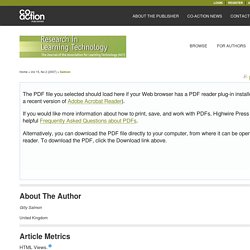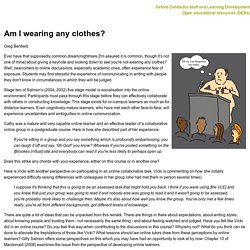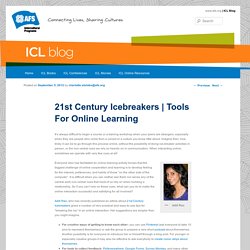

Five Stage Model - Gilly Salmon. Challenging the five-stage model for e-learning: a new approach. The PDF file you selected should load here if your Web browser has a PDF reader plug-in installed (for example, a recent version of Adobe Acrobat Reader).

If you would like more information about how to print, save, and work with PDFs, Highwire Press provides a helpful Frequently Asked Questions about PDFs. Alternatively, you can download the PDF file directly to your computer, from where it can be opened using a PDF reader. To download the PDF, click the Download link above. Fullscreen Fullscreen Off Article Metrics 815This journal 975This journal Metrics powered by PLOS ALM Related Content. The tipping point. The PDF file you selected should load here if your Web browser has a PDF reader plug-in installed (for example, a recent version of Adobe Acrobat Reader).

If you would like more information about how to print, save, and work with PDFs, Highwire Press provides a helpful Frequently Asked Questions about PDFs. Alternatively, you can download the PDF file directly to your computer, from where it can be opened using a PDF reader. To download the PDF, click the Download link above. Fullscreen Fullscreen Off Article Metrics 426This journal 210This journal. Am I wearing any clothes? Greg Benfield Ever have that supposedly common dream/nightmare [I'm assured it is common, though it's not one of mine] about giving a keynote and looking down to see you're not wearing any clothes?

Well, newcomers to online discussions, especially academic ones, often experience fear of exposure. Students may find stressful the experience of communicating in writing with people they don't know in circumstances in which they will be judged. Stage two of Salmon's (2004; 2002) five stage model is socialisation into the online environment. Participants must pass through this stage before they can effectively collaborate with others in constructing knowledge. Cathy was a mature and very capable online learner and an effective leader of a collaborative online group in a postgraduate course. If you're sitting in a group and you say something which is profoundly embarrassing, you can laugh it off and say, 'Oh God! ' Prompt questions about online course inductions. Think about online courses you've participated in (including this one).How did they try and induct you into the course?

Examples: introductions discussion boards (participants talking to each other? Talking into the void? Tutors responding?) Welcome videos/podcasts from tutorsintroductory webinarsice breaker activities (what sort? In groups or individually?) Tooc15: Readings. 21st Century Icebreakers. It’s always difficult to begin a course or a training workshop when your peers are strangers, especially when they are people who come from a conext or a culture you know little about.

Imagine then, how tricky it can be to go through this process online, without the possibility of doing ice-breaker activities in person, or the non-verbal cues we rely so heavily on in communication. When interacting online, sometimes we operate with very few cues at all! Aditi Rao Everyone who has facilitated an online learning activity knows that the biggest challenge of online cooperation and learning is to develop feeling for the interest, preferences, and habits of those “on the other side of the computer”. It is difficult when you can neither see them nor sense any of the (verbal and) non-verbal cues that most of us rely on when building a relationship.
For more tips to having successful interactions online and links to resources on Aditi Rao’s blog visit TeachBytes. Word Cloud for this article. 21st Century Icebreakers: 13 Ways To Get To Know Your Students with Technology. In honor of the start of a new school year, I am sharing one of my popular posts again with you with a couple of new additions!

On Monday I will begin my new job. As I’ve mentioned before, I will be working as a Technology Resource Specialist as well as teaching a couple of classes. As always, I am nervous and excited for the first day of school, and eager to meet a new group of students. As an educator, I often find myself repeating the same icebreakers each year, trying to quickly get to know my students through “Two Truths and a Lie” or a “Getting To Know You” fact sheet. In an effort to bring my own classroom to the present, I’ve put together a list of 13 icebreakers that use technology and fit with 21st century students: Have students create a Pinterest board with 10 pins that summarizes them.Ask students to create a 30 second podcast that introduces themselves. Have any other 21st century icebreakers? Like this: Like Loading...